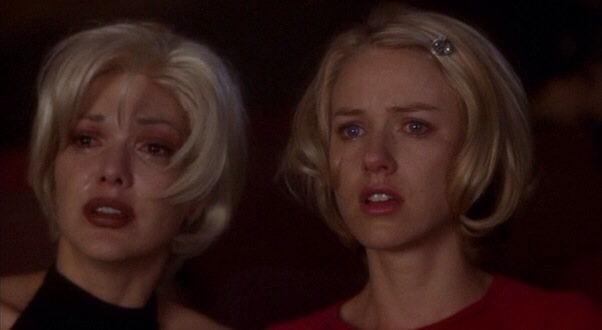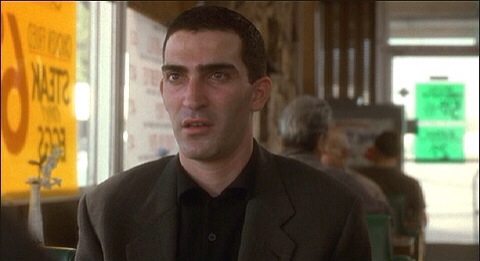Mulholland Drive 2001 by David Lynch follows a cryptic narrative that connects a series of seemingly unrelated darkly comic vignettes in various ways. It can be viewed as a neo-noir film that follows the ambitions of an aspiring actress named Betty (Naomi Watts) who lives in Hollywood, who meets an amnesic woman (Laura Harring) in her aunts apartment. Originally, Lynch conceived this film as a television pilot, although this was rejected by television executives- eventually leading to a longer feature film. This half-feature result has left the linear narrative open to interpretation. One interpretation of the film looks into dream analysis to explain that the real Diane Selwyn- casts her dream-self as the innocent and hopeful “Betty Elms”, reconstructing her history and persona into something like an old Hollywood film. Betty is successful, charming and lives the fantasy life of a soon-to-be-famous actress. In comparison the end of the film represents Diane’s bleak life, in which she has failed personally and professionally. Diane arranges for Camilla, a cold ex-lover, to be killed, and unable to cope with the guilt, re-imagines her as the dependant amnesiac Rita.
An early interpretation of the film uses dream analysis to explain that the first part is a dream of the real Diane Selwyn, who has cast her dream-self as the innocent and hopeful “Betty Elms”, reconstructing her history and persona into something like an old Hollywood film. In the dream, Betty is successful, charming, and lives the fantasy life of a soon-to-be-famous actress. The last one-fifth of the film presents Diane’s bleak real life, in which she has failed both personally and professionally. She arranges for Camilla, a cold ex-lover, to be killed, and unable to cope with the guilt, re-imagines her as the dependent, pliable amnesiac named Rita. Clues to her inevitable demise, however, continue to appear throughout her dream.
“I thought Diane was the real character and that Betty was the person she wanted to be and had dreamed up. Rita is the damsel in distress and she’s in absolute need of Betty, and Betty controls her as if she were a doll. Rita is Betty’s fantasy of who she wants Camilla to be.”
– Naomi Watts, interview
 http://www.slantmagazine.com/film/review/mulholland-drive
http://www.slantmagazine.com/film/review/mulholland-drive
This film can be viewed as having both an internal structure and an external one. The films internal structure is it’s most complex through the way Mullholland Drive(2001) provides material that refers back to itself, creating overlapping dramatic constructions that can be linked together into a coherent whole. The end of the movie is connected to the beginning of the movie with some type of twist that cannot be figured out by the viewer. With this type of structure, you cannot really understand one fundamental part of the movie without the other, however they each follow different logical paths that meet up in more than one strange way. For instance, in Mulholland Drive there are three opening sequences to the fantasy portion of the movie that make very distinct and very dramatic connections to scenes near the end in the reality portion of the movie. These different connections work together to help us understand the movie’s internal structure. The scenes that I am referring to are: the accident scene, the scene with the two men at the diner, and the scene with the chain phone call. I will explain their connection to scenes near the end of the movie at a later point below, but it is important to understand that to view the movie this way, you must have a theory about what type of puzzle pieces are involved in this movie. And, as it turns out, I think you must have a particular view of the external structure of the movie to develop a consistent theory about the puzzle pieces that make up its internal structure.
The external structure involves primarily how the movie paces itself and how it references other works. In some cases the parallels with other works provide a type of superstructure within which the internal dynamics can be placed, and then independently developed. Clearly, Lynch references his own past works in this film. Yet, since those references are so deeply integrated into the whole film, I believe that they are best seen as features of the internal structure. However, his references to the works of other artist are more instructive concerning what I am calling the external structure. The work of Stanley Kubrick is involved with his meticulous set designs, and his focus on surrealism, the nature of obsession and non-linear story lines. There are also examples of both Ingmar Bergman’s and Federico Fellini’s existentialist use of dream sequences and flashbacks, along with their explorations of violence, sexuality and humor. We also see hints of Akira Kurosawa and his intellectual spiritualism and artistry. And we find Krzysztof Kieslowski’s use of the doppelganger and color themes to examine the psyche and intellectual moralism. Indeed, there are also many other artists and films to which Lynch pays homage, but I believe Bergman is one who bears mentioning a second time to honor the importance that his focus on the struggle with duality in the psyche has become in Lynch’s work. His pivotal film, “Persona,” lays the foundation upon which Lynch builds the idea that you can answer questions about your own identity by exploring another individual’s projected persona. Moreover, there is the character Elisabeth Vogler in Bergman’s “Persona,” and she is one more possible source for the name Betty, the protagonist in the fantasy portion of Lynch’s film.

http://www.seeing-stars.com/Locations/MulhollandDrive.shtml

